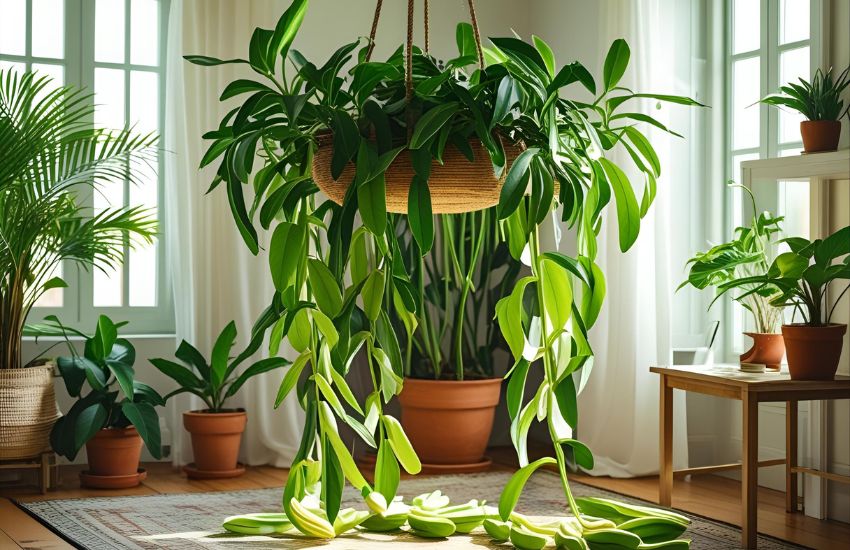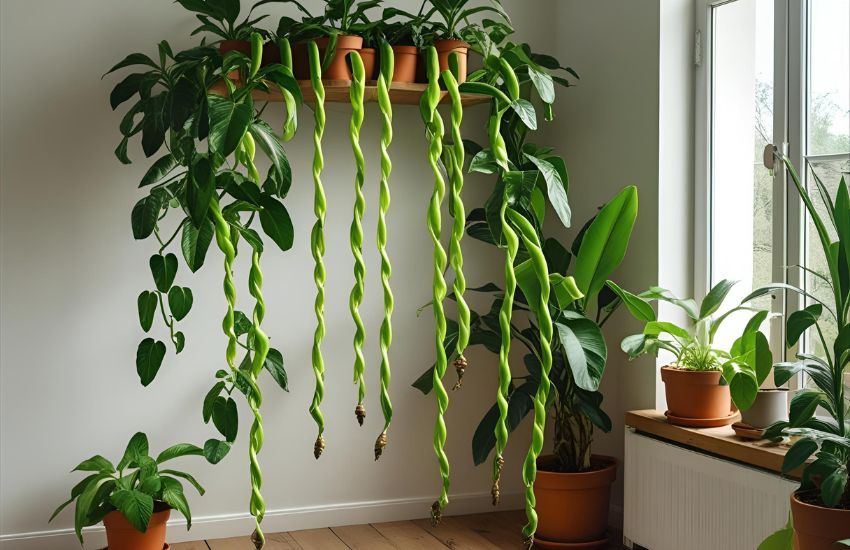If you’re seeking an elegant, easy-care trailing plant that adds charm to your indoor space, the string of bananas might be exactly what you need. Known for its cascading vines and banana-shaped leaves, this unique radicans variety is more than just eye-catching—it’s a resilient succulent well-suited for beginners and seasoned plant lovers alike. Growing Curio radicans indoors offers a rewarding experience, especially when you understand its needs for water, light, and the right potting soil.
The String of Bananas (Curio radicans) thrives indoors with bright, indirect light and well-draining soil. Water only when the soil has dried out completely to prevent root rot. Avoid letting the plant sit in water. This drought-tolerant succulent does not require frequent watering. Use a pot with adequate drainage for healthy growth.
In this care guide, you’ll discover practical tips for keeping your string of bananas vibrant—whether you’re growing it as a decorative houseplant or comparing it to a cactus in low-maintenance needs. Keep reading to explore expert advice on string of bananas care, step-by-step instructions to repot, and best practices for growing radicans successfully indoors.
Propagate, Repot, and Maintain Curio Radicans with Ease

How to Propagate Curio Radicans from Stem Cuttings
One of the simplest ways to expand your plant collection or rejuvenate an older specimen is by propagating senecio radicans—commonly known as the string of bananas—using stem cuttings. These cuttings root easily in the right conditions, making propagation an accessible task for any plant enthusiast. Choose healthy, firm vines with multiple banana-shaped leaves, and cut just below a node. Allow the cut ends to callous over for a day or two before placing them in well-draining soil. Keep the cuttings in bright light but out of direct light until new roots form.
When and How to Repot Your String of Bananas
Knowing when and how to repot is an essential part of plant care. The string of bananas requires repotting every couple of years or when it outgrows its container. Look for signs like compacted roots or slow growth. Use a succulent and cactus soil mix or a homemade potting mix that includes sand, perlite, or pumice for well-draining soil. Always ensure your container has drainage holes to avoid overwatering, a common problem for many succulents. Repotting is best done in spring and summer when the plant is actively growing.
Essential Maintenance Tips for a Thriving Plant
To care for string of bananas effectively, consistency is key. Develop a reliable watering schedule—allow the soil to dry out between waterings, but don’t let it stay dry for too long, as even hanging houseplants like this one need moisture to thrive. Avoid overwatering, and instead follow the habits of many succulents. Use a cactus soil base and fertilize lightly during the growing season to support healthy growth.
Position your plant in an area with enough light—ideally bright light near a window. In lower light environments, the vines may stretch and lose their compact shape. While commonly grown indoors, the string of bananas outdoors can also thrive in warm, dry climates with protection from harsh sun.
Can String of Bananas Grow Outdoors? Indoor vs. Outdoor Care

Understanding the Needs of This Trailing Succulent
The string of bananas is a trailing succulent that adds vibrant greenery to any setting, whether grown indoors or outside. Like other succulent varieties, it is drought-tolerant and thrives in dry, warm climates. To succeed in either environment, you must understand your succulent’s needs, especially when it comes to soil, light, and watering. Since string of bananas requires a well-draining soil, a succulent mix enhanced with part pumice or sand is ideal. A blend of part perlite and coarse sand helps boost aeration and help prevent root rot.
Outdoor Care: Light, Soil, and Climate
If you live in a region with mild winters, you can provide your string of bananas a comfortable home outdoors. Choose a shaded patio or garden corner that receives indirect light or higher light in the early morning but avoids scorching afternoon sun. Pumice or sand will provide the necessary drainage outdoors, especially when added to regular potting soil. If your plant is actively growing, you may need to go up one pot size to support healthy root development. Keep an eye on rainfall, as outdoor plants won’t follow a particular watering schedule—make sure to let the soil dry between waterings.
Indoor Conditions: Adjusting to Limited Light and Airflow
Indoors, select a spot in your home that offers plenty of bright, indirect light. While string of bananas succulents can tolerate low light for short periods, too much light or too little can lead to leaf drop or stretching. To keep your plant healthy indoors, monitor humidity levels—too much humidity can encourage fungal issues. Allow the soil to dry out before watering, and avoid overwatering by using containers with drainage holes.
Conclusion
Caring for Curio Radicans, or string of bananas, is a rewarding experience when you understand its unique needs. This resilient type of plant thrives in both indoor and outdoor settings as long as its conditions are properly managed. Whether you allow it to trail where you want in a sunny window or on a patio, remember that bananas does not require constant attention—but it does need the right environment to flourish.
Always ensure the soil has dried thoroughly between waterings to avoid root issues, and never leave the plant sitting in excess moisture. A mix of parts potting soil, coarse sand, and perlite or pumice is ideal, as the sand will provide your string of bananas with adequate drainage. If you’re keeping your plant outside, it must be kept indoors once temperatures begin to drop. Indoors, make sure you’re placing your plant where it’s getting enough light, so the plant looks full, healthy, and vibrant.
Ready to elevate your plant care routine? Use this guide to confidently grow and care for your string of bananas, and enjoy the lush beauty of a cascading succulent that brings calm and life to any space. Start today—your thriving indoor jungle awaits.
Frequently Asked Questions (String of Bananas Plant Care Guide: Grow Curio Radicans Indoors)
Can strings of bananas grow indoors?
Yes, String of Bananas (Curio radicans) can grow indoors if provided with bright, indirect sunlight and well-draining soil. Place it near a sunny window and water sparingly, allowing the soil to dry between waterings. With proper care, it thrives indoors, producing lush trailing vines that make it a perfect decorative hanging plant.
How do you care for a curio Radicans?
Curio radicans, also known as String of Bananas, thrives in bright, indirect light and well-draining soil. Water thoroughly but only when the soil is completely dry to prevent root rot. Keep it in a warm spot, ideally between 18–24°C. Fertilize monthly during the growing season and prune regularly to encourage fuller growth.
How to take care of a banana plant indoors?
To care for a banana plant indoors, place it in bright, indirect sunlight and maintain temperatures between 75–95°F. Keep the soil consistently moist but not soggy, and ensure good drainage. Mist the leaves regularly to maintain humidity. Fertilize monthly with a balanced fertilizer during the growing season for healthy growth and vibrant foliage.
How do you take care of a String of Bananas?
Care for a String of Bananas by placing it in bright, indirect sunlight and well-draining soil. Water only when the topsoil is dry, avoiding overwatering to prevent root rot. Keep temperatures between 60–80°F and provide good airflow. Fertilize monthly during the growing season for healthy growth and prune leggy stems to maintain its shape.
